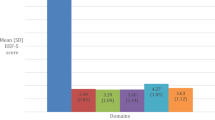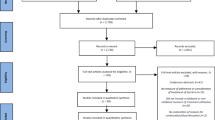Abstract
We investigated whether a preference by patients regarding the gender of a health care provider to manage erectile dysfunction (ED) may be a factor in the diagnosis and care of this condition, whose broader medical significance is an area of increasing interest. A brief questionnaire was completed by 1087 adult males in a primary care setting. The questionnaire explored provider gender preference and other possible biases. The prevalence of ED in the 40–69 age group in our population was 68.8%. The prevalence was 81% in the age group of 70 and more. Of those who reported having experienced ED, 51.5% had discussed it with a provider, and 28.1% had been treated. Approximately, 57% expressed no provider gender preference, regardless of history of ED. Of those who stated a preference, approximately 75% prefer male providers. However, also among those who state a preference, Hispanics are not as likely as non-Hispanics to prefer a male provider (P=0.03). Most believe that males and females are equally qualified to manage ED, but among those who have a different opinion, the gender perceived more favorably is male. The issue of privacy during the discussion of ED was also very important to the respondents in this study.
This is a preview of subscription content, access via your institution
Access options
Subscribe to this journal
Receive 8 print issues and online access
$259.00 per year
only $32.38 per issue
Buy this article
- Purchase on Springer Link
- Instant access to full article PDF
Prices may be subject to local taxes which are calculated during checkout
Similar content being viewed by others
References
Laumann EO, Nicolosi A, Glasser DB, Paik A, Gingell C, Moreira E et al. Sexual problems among women and men aged 40–80 y: prevalence and correlates identified in the Global Study of Sexual Attitudes and Behaviors. Int J Impot Res 2005; 17: 39–57.
Lewis RW, Fugl-Meyer KS, Bosch R, Fugl-Meyer AR, Laumann EO, Lizza E et al. Epidemiology/risk factors of sexual dysfunction. J Sex Med 2004; 1: 35–39.
Nicolosi A, Laumann EO, Glasser DB, Moreira A, Paik A, Gingell C et al. Sexual behavior and sexual dysfunctions after age 40: the Global Study of Sexual Attitudes and Behaviors. Urology 2004; 64: 991–997.
Feldman HA, Goldstein I, Hatzichristou DG, Krane RJ, McKinlay JB . Impotence and its medical and psychosocial correlates: results of the Massachusetts Male Aging Study. J Urol 1994; 151: 54–61.
Grover SA, Lowensteyn I, Kaouache M, Marchand S, Coupal L, DeCarolis E et al. The prevalence of erectile dysfunction in the primary care setting: importance of risk factors for diabetes and vascular disease. Arch Intern Med 2006; 166: 213–219.
Althof SE . Quality of life and erectile dysfunction. Urology 2002; 59: 803–810.
Shabsigh R, Klein LT, Seidman S, Kaplan SA, Lehrhoff BJ, Ritter JS . Increased incidence of depressive symptoms in men with erectile dysfunction. Urology 1998; 52: 848–852.
Litwin MS, Nied RJ, Dhanani N . Health-related quality of life in men with erectile dysfunction. J Gen Intern Med 1998; 13: 159–166.
NIH Consensus Conference. NIH consensus development panel on impotence. JAMA 1993; 270: 83–90.
Rosen RC, Fisher WA, Eardley I, Niederberger C, Nadel A, Sand M . The Multinational Men's Attitudes to Life Events and Sexuality (MALES) study: prevalence of erectile dysfunction and related health concerns in the general population. Curr Med Res Opin 2004; 20: 607–617.
http://bayerus.dev.h2web.com/msms/news/index.cfm?mode=detail&id=D9BAB916-0CAA-AB39-278057E7FDE84D2C.
Seftel A . Male hypogonadism. Part I: epidemiology of hypogonadism. Int J Impot Res. 2006; 18: 115–120.
Seftel A . Erectile Dysfunction aDecade Later: another Paradigm Shift. J Urol 2006; 176: 10–11.
Montorsi P, Ravagnani PM, Galli S, Salonia A, Briganti A, Werba JP et al. Association between erectile dysfunction and coronary artery disease: matching the right target with the right test in the right patient. Eur Urol 2006; 50: 721–731.
Montorsi P, Montorsi F, Schulman CC . Is erectile dysfunction the ‘tip of the iceberg’ of a systemic vascular disorder? Eur Urol 2003; 44: 352–354.
Kupelian V, Shabsigh R, Araujo AB, O'Donnell AB, McKinlay JB . Erectile dysfunction as a predictor of the metabolic syndrome in aging men: results from the Massachusetts Male Aging Study. J Urol 2006; 176: 222–226.
Johnson AM . Do women prefer care from female or male obstetrician–gynecologists? A study of patient gender preference. J Am Osteopath Assoc 2005; 105: 369–379.
Lafta RK . Practitioner gender preference among gynecologic patients in Iraq. Health Care Women Int 2006; 27: 125–130.
Weitzman PF, Chang G, Reynoso H . Middle-aged and older latino american women in the patient–doctor interaction. J Cross-Cultural Gerontol 2004; 19: 221–239.
Tamez EG . Familism, machismo and child rearing practices among Mexican Americans. J Psychosoc Nurs Ment Health Serv. 1981; 19: 21–25.
Toussaint L, Webb JR . Gender differences in the relationship between empathy and forgiveness. J Soc Psychol 2005; 145: 673–685.
Hakim J, Subit M, Maroon M, Jacques CH, Zaslau S . Screening for erectile dysfunction in the primary care practice: results of a survey. W V Med J 2005; 101: 67–70.
Rosen RC, Cappelleri JC, Smith MD, Lipsky J, Pena BM . Development and evaluation of an abridged, 5-item version of the International Index of Erectile Function (IIEF-5) as a diagnostic tool for erectile dysfunction. Int J Impot Res 1999; 11: 319–326.
Cappelleri JC, Siegel RL, Glasser DB, Osterloh IH, Rosen RC . Relationship between patient self-assessment of erectile dysfunction and the sexual health inventory for men. Clin Ther 2001; 23: 1707–1719.
Jiann BP, Yu CC, Su CC, Tsai JY . Compliance of sildenafil treatment for erectile dysfunction and factors affecting it. Int J Impot Res 2006; 8: 146–149.
Shann S, Wilson JD . Patients' attitudes to the presence of medical students in a genitourinary medicine clinic: a cross sectional survey. Sex Transm Infect 2006; 82: 52–54.
Acknowledgements
This work was supported by an Educational Research Grant Award from the Consortium for Improvement in Erectile Function.
Author information
Authors and Affiliations
Corresponding author
Rights and permissions
About this article
Cite this article
Carrejo, M., Balla, D. & Tan, R. Preference for gender of health care provider in management of erectile dysfunction. Int J Impot Res 19, 474–479 (2007). https://doi.org/10.1038/sj.ijir.3901553
Received:
Revised:
Accepted:
Published:
Issue Date:
DOI: https://doi.org/10.1038/sj.ijir.3901553
Keywords
This article is cited by
-
How do applicants, students and physicians think about the feminisation of medicine? - a questionnaire-survey
BMC Medical Education (2020)



